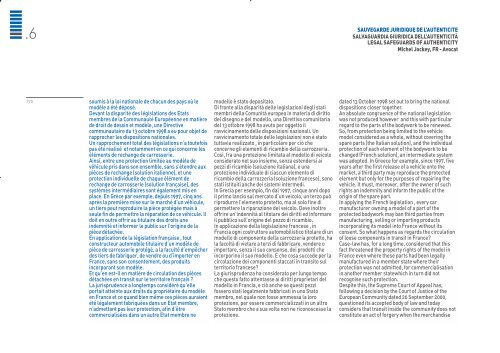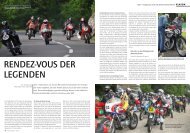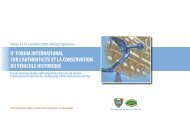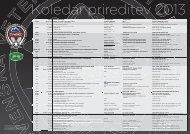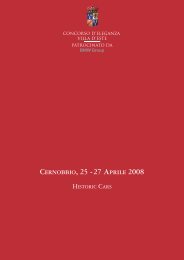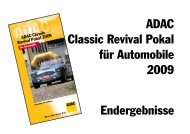FORUM INTERNATIONAL SUR L'AUTHENTICITE DU VEHICULE HISTORIQUE ...
FORUM INTERNATIONAL SUR L'AUTHENTICITE DU VEHICULE HISTORIQUE ...
FORUM INTERNATIONAL SUR L'AUTHENTICITE DU VEHICULE HISTORIQUE ...
Create successful ePaper yourself
Turn your PDF publications into a flip-book with our unique Google optimized e-Paper software.
.6<br />
170<br />
soumis à la loi nationale de chacun des pays où le<br />
modèle a été déposé.<br />
Devant la disparité des législations des Etats<br />
membres de la Communauté Européenne en matière<br />
de droit de dessin et modèle, une Directive<br />
communautaire du 13 octobre 1998 a eu pour objet de<br />
rapprocher les dispositions nationales.<br />
Un rapprochement total des législations n’a toutefois<br />
pas été réalisé et notamment en ce qui concerne les<br />
éléments de rechange de carrosserie.<br />
Ainsi, entre une protection limitée au modèle de<br />
véhicule pris dans son ensemble, sans s’étendre aux<br />
pièces de rechange (solution italienne), et une<br />
protection individuelle de chaque élément de<br />
rechange de carrosserie (solution française), des<br />
systèmes intermédiaires sont également mis en<br />
place. En Grèce par exemple, depuis 1997, cinq ans<br />
après la première mise sur le marché d’un véhicule,<br />
un tiers peut reproduire la pièce protégée mais à<br />
seule fin de permettre la réparation de ce véhicule. Il<br />
doit en outre offrir au titulaire des droits une<br />
indemnité et informer le public sur l’origine de la<br />
pièce détachée.<br />
En application de la législation française , tout<br />
constructeur automobile titulaire d’un modèle de<br />
pièce de carrosserie protégé, a la faculté d’empêcher<br />
des tiers de fabriquer, de vendre ou d’importer en<br />
France, sans son consentement, des produits<br />
incorporant son modèle.<br />
Et qu’en est-il en matière de circulation des pièces<br />
détachées en transit sur le territoire français ?<br />
La jurisprudence a longtemps considéré qu’elle<br />
portait atteinte aux droits du propriétaire du modèle<br />
en France et ce quand bien même ces pièces auraient<br />
été légalement fabriquées dans un Etat membre,<br />
n’admettant pas leur protection, afin d’être<br />
commercialisées dans un autre Etat membre ne<br />
modello è stato depositato.<br />
Di fronte alla disparità delle legislazioni degli stati<br />
membri della Comunità europea in materia di diritto<br />
del disegno e del modello, una Direttiva comunitaria<br />
del 13 ottobre 1998 ha avuto per oggetto il<br />
ravvicinamento delle disposizioni nazionali. Un<br />
ravvicinamento totale delle legislazioni non è stato<br />
tuttavia realizzato , in particolare per ciò che<br />
concerne gli elementi di ricambio della carrozzeria.<br />
Così, fra una protezione limitata al modello di veicolo<br />
considerato nel suo insieme, senza estendersi ai<br />
pezzi di ricambio (soluzione italiana), e una<br />
protezione individuale di ciascun elemento di<br />
ricambio della carrozzeria (soluzione francese), sono<br />
stati istituiti anche dei sistemi intermedi.<br />
In Grecia per esempio, fin dal 1997, cinque anni dopo<br />
il primo lancio sul mercato d’un veicolo, un terzo può<br />
riprodurre l’elemento protetto, ma al solo fine di<br />
permettere la riparazione del veicolo. Deve inoltre<br />
offrire un’indennità al titolare dei diritti ed informare<br />
il pubblico sull’origine del pezzo di ricambio.<br />
In applicazione della legislazione francese , in<br />
Francia ogni costruttore automobilistico titolare di un<br />
modello di componente della carrozzeria protetto, ha<br />
la facoltà di vietare a terzi di fabbricare, vendere o<br />
importare, senza il suo consenso, dei prodotti che<br />
incorporino il suo modello. E che cosa succede per la<br />
circolazione dei componenti staccati in transito sul<br />
territorio francese?<br />
La giurisprudenza ha considerato per lungo tempo<br />
che questo fatto attentasse ai diritti proprietari del<br />
modello in Francia, e ciò anche se questi pezzi<br />
fossero stati legalmente fabbricati in uno Stato<br />
membro, nel quale non fosse ammessa la loro<br />
protezione, per essere commercializzati in un altro<br />
Stato membro che a sua volta non ne riconoscesse la<br />
protezione.<br />
SAUVEGARDE JURIDIQUE DE L’AUTENTICITE<br />
SALVAGUARDIA GIURIDICA DELL’AUTENTICITÀ<br />
LEGAL SAFEGUARDS OF AUTHENTICITY<br />
Michel Jockey, FR - Avocat<br />
dated 13 October 1998 set out to bring the national<br />
dispositions closer together.<br />
An absolute congruence of the national legislation<br />
was not produced however and this with particular<br />
regard to the parts of the bodywork to be renewed.<br />
So, from protection being limited to the vehicle<br />
model considered as a whole, without covering the<br />
spare parts (the Italian solution), and the individual<br />
protection of each element of the bodywork to be<br />
changed (French solution), an intermediate system<br />
was adopted. In Greece for example, since 1997, five<br />
years after the first release of a vehicle onto the<br />
market, a third party may reproduce the protected<br />
element but only for the purposes of repairing the<br />
vehicle. It must, moreover, offer the owner of such<br />
rights an indemnity and inform the public of the<br />
origin of the spare part.<br />
In applying the French legislation , every car<br />
manufacturer owning a model of a part of the<br />
protected bodywork may ban third parties from<br />
manufacturing, selling or importing products<br />
incorporating its model into France without its<br />
consent. So what happens as regards the circulation<br />
of loose components in transit in France?<br />
Case-law has, for a long time, considered that this<br />
fact threatened the property rights of the model in<br />
France even where these parts had been legally<br />
manufactured in a member state where their<br />
protection was not admitted, for commercialisation<br />
in another member statewhich in turn did not<br />
recognise such protection.<br />
Despite this, the Supreme Court of Appeal has,<br />
following a decision by the Court of Justice of the<br />
European Community dated 26 September 2000,<br />
questioned its accepted body of law and today<br />
considers that transit inside the community does not<br />
constitute an act of forgery when the merchandise


